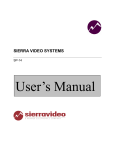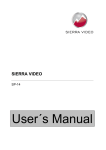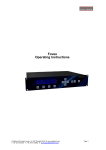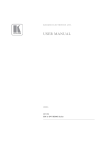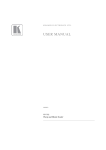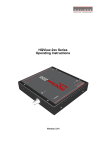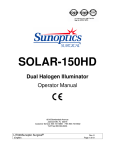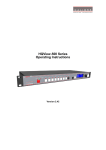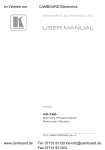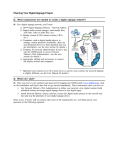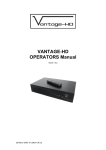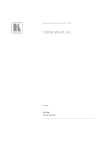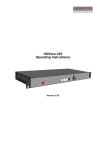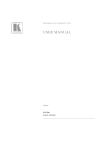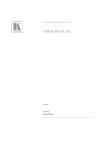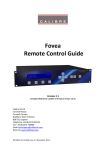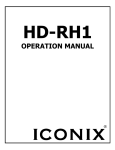Download VideoExcel User Manual version 4.00
Transcript
VideoExcel Operating Instructions © Calibre UK Limited Issue 4.00 22nd January 2014, W: www.calibreuk.com T:+44 1274 394125 F: +44 1274 730960 E: [email protected], Page 1 This manual explains how to operate your VideoExcel television broadcast image processors. The products are designed to provide users with a powerful and flexible method of format conversion. If you have any queries relating to this or any other product supplied by Calibre please visit our web site www.calibreuk.com. For technical support please e-mail [email protected] or send your queries by fax to (44) 1274 730960, for the attention of our Technical Support Department. COPYRIGHT This document and the software described within it are copyrighted with all rights reserved. Under copyright laws, neither the documentation nor the software may be copied, photocopied, reproduced, translated, or reduced to electronic medium or machine readable form, in whole or in part, without prior written consent of Calibre UK Ltd ("Calibre"). Failure to comply with this condition may result in prosecution. Calibre does not warrant that this product will function properly in every hardware/software environment. Although Calibre has tested the hardware, firmware, software and reviewed the documentation, CALIBRE MAKES NO WARRANTY OR REPRESENTATION, EITHER EXPRESS OR IMPLIED, WITH RESPECT TO THIS HARDWARE, FIRMWARE, SOFTWARE OR DOCUMENTATION, THEIR QUALITY, PERFORMANCE, MERCHANTABILITY, OR FITNESS FOR A PARTICULAR PURPOSE. THIS SOFTWARE AND DOCUMENTATION ARE LICENSED 'AS IS', AND YOU, THE LICENSEE, BY MAKING USE THEREOF, ARE ASSUMING THE ENTIRE RISK AS TO THEIR QUALITY AND PERFORMANCE. IN NO EVENT WILL CALIBRE BE LIABLE FOR DIRECT, INDIRECT, SPECIAL, INCIDENTAL, OR CONSEQUENTIAL DAMAGES ARISING OUT OF THE USE OR INABILITY TO USE THE SOFTWARE OR DOCUMENTATION, even if advised of the possibility of such damages. In particular, and without prejudice to the generality of the foregoing, Calibre has no liability for any programs or data stored or used with Calibre software, including costs of recovering such programs or data. Calibre UK Ltd Cornwall House, Cornwall Terrace Bradford, West Yorkshire BD8 7JS, England Telephone Fax Email Web-site Copyright +44 (0)1274 394125 + 44 (0)1274 730960 [email protected] www.calibreuk.com (c) 2014 All World-wide Rights Reserved All trade marks acknowledged Calibre operates a policy of continued product improvement; therefore specifications are subject to change without notice as products are updated or revised. E&OE. © Calibre UK Limited Issue 4.00 22nd January 2014, W: www.calibreuk.com T:+44 1274 394125 F: +44 1274 730960 E: [email protected], Page 2 Contents INTRODUCTION 1.1. General Introduction 1.1.1. Front Panel Control 1.1.2. Rear Panel conectivity 1.2. Packing List SYSTEM DESCRIPTION 2.1. Product Overview 2.2. Product Specification 2.2.1. Power Supply Requirement 2.2.2. Video Inputs 2.2.3. Component Video Inputs 2.2.4. SDI Input 2.2.5. Analogue VGA Input 2.2.6. HDMI & DVI Inputs 2.2.7. Audio Inputs 2.2.8. Audio Output 2.2.9. Display Output 2.3. Genlock 2.4. Closed Captioning and VITC Support FLOW CHART FOR VIDEOEXCEL OPERATION 3.1. Correct Installation Order FRONT PANEL CONTROL 4.1. Menu Tree 4.2. Introduction 4.3. Start-up Screen 4.4. Main Menu 4.5. Input Select 4.6. Input Adjust 4.6.1. Input Levels 4.6.2. Clock/Position 4.6.3. Pan/Zoom/Tilt 4.6.4. Input Capture 4.6.5. Input Features 4.6.6. Aspect Ratio 4.6.7. Aspect Ratio 4.6.8. Filters 4.6.9. Audio Channel Swap 4.7. Output Adjust 4.7.1. Lock Mode 4.7.2. Reference Source 4.7.3. Reference Offset 4.7.4. Free Run Format 4.7.5. ARC Mode 4.7.6. ARC Custom 4.7.7. Processing Mode 4.7.8. 3G-SDI Data Map 4.7.9. Blue Check 4.7.10. Safe Area Markers 4.7.11. Vertical Filter 4.7.12. Gamma of Display 4.8. Information 4.9. Miscellaneous 4.9.1. Select Test Pattern 4.9.2. Status Display Mode 4.9.3. Channel Logo Overlay 4.9.4. Input Channel Config 4.9.5. No Sync Color 4.9.6. Factory Reset 4.9.7. Unit Configuration 4.9.8. Networking(TCP/IP) 4.9.9. Presets © Calibre UK Limited Issue 4.00 22nd January 2014, W: www.calibreuk.com T:+44 1274 394125 F: +44 1274 730960 E: [email protected], 6 6 6 7 8 9 9 9 9 9 9 10 10 10 10 10 11 11 11 12 12 13 13 16 17 17 17 18 18 18 18 19 19 19 20 20 21 22 22 22 22 22 22 23 23 23 23 23 24 24 25 25 25 25 25 25 26 26 26 26 27 Page 3 REMOTE CONTROL WEB SERVER 5.1. Introduction 5.2. Installing the Software 5.3. Software Operation 5.4. Channel Logo Upload FIRMWARE UPDATE 6.1. Introduction 6.2. Installing the PC Updater Software 6.3. Updating Firmware ENVIRONMENTAL AND EMC 7.1. Recommended Operating Conditions 7.2. Storage 7.3. CE and FCC Compliance ABBREVIATIONS © Calibre UK Limited Issue 4.00 22nd January 2014, W: www.calibreuk.com T:+44 1274 394125 F: +44 1274 730960 E: [email protected], 28 28 28 28 28 29 29 29 29 30 30 30 30 31 Page 4 SAFETY WARNING: 1. THERE ARE NO USER SERVICEABLE PARTS WITHIN THE UNIT. REMOVAL OF THE TOP COVER WILL EXPOSE DANGEROUS VOLTAGES. DO NOT OPERATE THE UNIT WITHOUT THE TOP COVER INSTALLED. 2. ENSURE THAT ALL ELECTRICAL CONNECTIONS (INCLUDING THE MAINS PLUG AND ANY EXTENSION LEADS) ARE PROPERLY MADE AND COMPLY WITH ELECTRICAL SAFETY REGULATIONS. 3. ENSURE THAT THE INTEGRITY OF THE EQUIPMENT ISOLATION BARRIER IS MAINTAINED WHEN CONNECTING TO OTHER EQUIPMENT. THIS MEANS THAT ONLY LOW VOLTAGE ISOLATED CIRCUITS MAY BE CONNECTED TO THE SIGNAL INPUTS AND OUTPUTS. IF ANY DOUBT EXISTS CONSULT QUALIFIED SERVICE PERSONNEL. 4. TO PREVENT SHOCK OR FIRE HAZARD DO NOT EXPOSE THIS EQUIPMENT TO RAIN OR MOISTURE. IF SUCH EXPOSURE OCCURS, REMOVE THE PLUG FROM THE MAINS OUTLET AND HAVE THE EXPOSED UNIT CHECKED BY QUALIFIED SERVICE PERSONNEL. 5. DO NOT CONTINUE TO OPERATE THE EQUIPMENT IF YOU HAVE ANY DOUBT ABOUT IT WORKING NORMALLY, OR IF IT IS DAMAGED IN ANY WAY. WITHDRAW THE MAINS PLUG FROM THE MAINS OUTLET AND CONSULT QUALIFIED SERVICE PERSONNEL. 6. DO NOT REMOVE ANY FIXED COVERS UNLESS YOU ARE QUALIFIED TO DO SO AND EVEN THEN WITHDRAW THE MAINS PLUG FROM THE MAINS OUTLET BEFORE YOU START. 7. THIS EQUIPMENT CONTAINS NO USER SERVICEABLE PARTS. MAINTENANCE TO QUALIFIED SERVICE PERSONNEL. 8. TO AVOID EXPLOSION, DO NOT OPERATE THIS EQUIPMENT IN AN EXPLOSIVE ATMOSPHERE © Calibre UK Limited Issue 4.00 22nd January 2014, W: www.calibreuk.com T:+44 1274 394125 F: +44 1274 730960 E: [email protected], REFER ALL SERVICING AND Page 5 INTRODUCTION 1.1. General Introduction VideoExcel is a very flexible television broadcast image processor developed to convert between PC and video formats. It features state of the art digital image processor with powerful scaling using up to 1024-tap filter and market leading HD & SD per-pixel multiple Iow-angle aperture-adjusted motion-adaptive de-interlacing with automatic film pull-down correction for 3:2, 2:2 and non-standard and broken cadences, significantly outperforming the capabilities of benchmark competitor products. VideoExcel features HQV post-production studio-grade image processing algorithms for the very best scaling, film and video noise reduction, MPEG artifact reduction and automatic audio time-line correction to maintain lip-sync. VideoExcel-75 is designed with special emphasis on progressive PC modes to video formats conversion. It has flicker reduction for interlaced video outputs, de-interlacing on the input and noise reduction is not provided. VideoExcel-150 provide both PC connectivity and de-interlacing with noise reduction. VideoExcel is a very flexible video and audio router with multiple digital and analog input channels, digital audio and/or analog audio support and SDI/HD-SDI/3G-SDI compatibility. The image may be zoomed and panned to select a particular area of interest. Scaling and aspect ratio treatment is extremely flexible. 1.1.1. Front Panel Control System control is via a front-panel LCD menu controlled via keys or through a web interface via TCP/IP. All VideoExcel (and FoveaHD) feature the same front panel control, but different connectivity through the rear panel. 4 7 1 2 5 6 3 1: Menu display 4: Menu navigation keys 7: Standby 2: Bore (Reset knob access) 3: (Programmable) input channel select keys 5: Menu key 6: Toggle input channels © Calibre UK Limited Issue 4.00 22nd January 2014, W: www.calibreuk.com T:+44 1274 394125 F: +44 1274 730960 E: [email protected], Page 6 1.1.2. Rear Panel conectivity VideoExcel-75HD VideoExcel-75HD uses a very high performance video input front end including HDMI, DVI with HDCP encryption and analog RGBHV graphics input. The output format can be set to a great number of different standard video modes from NTSC to 2k modes performing time base correction or the output can be genlocked to the incoming video signal. Outputs are available in analogue component, DVI digital and 3G-SDI formats which are useable simultaneously. Note that if an HDCP encrypted signal is connected to the HDMI or DVI input, the DVI output signal will be similarly HDCP encrypted and the other outputs will be disabled. 3 1 4 2 10 5 6 7 8 11 9 11 1: HDMI input 2: DVI-D input 3: RGBHV input 4: YPbPr output 5: Control Ports (RS232, TCP/IP and USB) 6: 3G-SDI output 7: DVI/HDMI output 8: Analogue Genlock input and output 9: SDI Genlock input and output 10: 1x digital audio in (coaxial), 1x analogue Stereo R/L in/4x AES audio outputs 11: Dual redundant power supply VideoExcel-100HD VideoExcel-100HD uses a very high performance video input front end including true component video support in analog YPbPr and RGBS formats and SDI/HD-SDI/3G-SDI digital formats as well as dual composite (CVBS) and a Y/C S-Video input. A very high performance video decoder is utilised with 4x oversampling and 3D Y/C cross talk filter for outstanding video image clarity. HDMI and DVI video with HDCP encryption is also supported. The output format can be set to a great number of different standard video modes from NTSC to 2k modes performing time base correction or the output can be genlocked to the incoming video signal. Outputs are available in analog component, DVI digital and 3G-SDI formats which are useable simultaneously. Note that if an HDCP encrypted signal is connected to the HDMI or DVI input, the DVI output signal will be similarly HDCP encrypted and the other outputs will be disabled. 13 6 12 13 1 2 3 4 1: HDMI input 2: DVI-D input 5: Y/C and 2x CVBS inputs 6: YPbPr output 8: 3G-SDI output 9: DVI/HDMI output 11: SDI Genlock input and output 13: Dual redundant power supply 5 7 8 9 10 11 3: 2x 3G-SDI inputs 4: YPbPr/RGBS input 7: Control Ports (RS232, TCP/IP and USB) 10: Analogue Genlock input and output 12: 4x/4x AES audio inputs (top)/ outputs (bottom) © Calibre UK Limited Issue 4.00 22nd January 2014, W: www.calibreuk.com T:+44 1274 394125 F: +44 1274 730960 E: [email protected], Page 7 VideoExcel-150D VideoExcel-150HD uses a very high performance video input front end including true component video support in analog YPbPr and RGBS formats and SDI/HD-SDI/3G-SDI digital formats as well as dual composite (CVBS) and a Y/C S-Video input. A very high performance video decoder is utilised with 4x oversampling and 3D Y/C cross talk filter for outstanding video image clarity. HDMI and DVI video with HDCP encryption is supported as well as analog RGBHV graphics input. The output format can be set to a great number of different standard video modes from NTSC to 2k modes performing time base correction or the output can be genlocked to the incoming video signal. Outputs are available in analog component, DVI digital and 3G-SDI formats which are useable simultaneously. Note that if an HDCP encrypted signal is connected to the HDMI or DVI input, the DVI output signal will be similarly HDCP encrypted and the other outputs will be disabled. 4 7 14 3 13 14 1 2 3 5 6 1: HDMI input 2: DVI-D input 5: YPbPr/RGBS input 6: Y/C and 2x CVBS inputs 8: Control Ports (RS232, TCP/IP and USB) 11: Analogue Genlock input and output 13: 4x/4x AES audio inputs (top)/ outputs (bottom) 1.2. 8 9 10 0 11 12 3: 2x 3G-SDI inputs 4: RBGHV input 7: YPbPr output 9: 3G-SDI output 10: DVI/HDMI output 12: SDI Genlock input and output 14: Dual redundant power supply Packing List VideoExcel-75HD, -100HD, and -150HD is supplied with the following 1) This manual 2) 3 pin plug IEC mains cable 3) DVI-D output cable © Calibre UK Limited Issue 4.00 22nd January 2014, W: www.calibreuk.com T:+44 1274 394125 F: +44 1274 730960 E: [email protected], Page 8 SYSTEM DESCRIPTION 2.1. Product Overview VideoExcel are designed to accept the following input signals. FoveaHD is shown for comparison. 2x Composite video via BNC S-Video Y/C via 2x BNC YPbPr or RGBS SD/ED/HD component video via 3/4x BNC VGA input via 5x BNC connectors (RGBHV) 2x 3G-SDI/HD-SDI/SDI (Serial Digital Interface) via BNC DVI-D (Digital Visual Interface) via a DVI-I connector HDMI via HDMI connector 2.2. VXL-75HD No No No VXL-100HD Yes Yes Yes VXL-150HD Yes Yes Yes FoveaHD Yes Yes Yes Yes No Yes Yes No Yes Yes Yes Yes Yes Yes Yes Yes Yes Yes Yes Product Specification This section provides technical details for all possible inputs. Please note that not all possible input options may be applicable to certain output modes. 2.2.1. Power Supply Requirement VideoExcel has two internal power supplies. The unit can be set up to work from a single power supply or as a fail save mechanism switch between the power supplies in case of one failing. Each mains input is rated 100V-264VAC 50/60Hz with maximum power of 60W connected via a standard IEC connectors located on the rear panel. The power input socket contains a fuse which should only be replaced with the same type and rating for continued product safety. The correct type and rating of fuse is stated on a label on the side or rear of the equipment. 2.2.2. Video Inputs Composite via BNC connectors, S-Video Y/C via 2x BNC connectors Signal formats Composite (CVBS) input level Luminance (Y) input level Chrominance (C) input level Input Impedance (all inputs) 2.2.3. Composite (CVBS), S-Video (Y/C), Standards NTSC, PAL, SECAM 1V p-p nominal inc. sync 1V p-p nominal inc. sync 0.6V p-p nominal 75 Ohms Component Video Inputs Via 3 or 4 BNC connectors YPbPr, YPbPrS, RGB and RGBS component video, menu selectable. Signal formats 484i (480i) and 576i (SD), 480p, 576p (ED), 720p, 1080i at 50, 59.94 and 60Hz and 1080p at 24, 25, 29.97 and 30Hz. Please note this input does not support Computer SVGA signals. © Calibre UK Limited Issue 4.00 22nd January 2014, W: www.calibreuk.com T:+44 1274 394125 F: +44 1274 730960 E: [email protected], Page 9 2.2.4. SDI Input Format: Input impedance: SD-SDI HD-SDI YCbCr 4:2:2 serial digital component video 3G-SDI 4:2:2 and 4:4:4 serial digital component video 75 ohms. SMPTE 292M, SMPTE 259M-C and SMPTE 424M compliant, accepts 484i, 576i, 720, 1080i and 1080p single link formats at 270Mb, 1.485Gb or 2.97Gb rates. Level A and B transport is supported for 1080p 50, 59.94 and 60 Hz (2.97Gb rates). 2.2.5. Analogue VGA Input Via 5 BNC connectors Signal formats: 640x480, 720x400, 800x600, 1024x600, 1024x768, 1280x720, 1280x768, 1280x1024, 1360x768, 1400x1050, 1440x900, 1680x1050, 1920x1080 Please note this input does not support video type signals. 2.2.6. HDMI & DVI Inputs HDMI 1.3 with or without HDCP, 30-bit video compatible. DVI-D input with or without HDCP VideoExcel-100HD, and -150HD Video signal formats 484i and 576i (SD) in double-rate formats (1440 pixels per line), 480p, 576p (ED), 720p, 1080i at 50, 59.94 & 60Hz, 1080p at 24, 25, 30, 50, 59.94 & 60Hz. VideoExcel-75HD, and -150HD Graphic signal formats 640x480, 800x600, 852x480, 853x480, 1024x600, 1024x768, 1280x720, 1280x768, 1280x800, 1280x960 1280x1024, 1360x768, 1365x768, 1366x768, 1368x768, 1400x788, 1440x900, 1600x900, 1366x1024, 1400x1050, 1680x1050, 1600x1200, 1920x1080, 1920x1200 2.2.7. Audio Inputs VideoExcel-100HD, and -150HD AES coaxial digital audio (4x) VideoExcel-75HD Analog stereo L/R SPDIF coaxial digital audio 2.2.8. Audio Output AES coaxial digital audio (4x) © Calibre UK Limited Issue 4.00 22nd January 2014, W: www.calibreuk.com T:+44 1274 394125 F: +44 1274 730960 E: [email protected], Page 10 2.2.9. Display Output Three output channels are provided, 3G-SDI via BNC, DVI-D via a DVI-I connector and Component Video Output via three BNC, which are useable simultaneously, provided the input signal is not HDCP encrypted. Please note that this unit is HDCP compliant. This means that when the input signal has HDCP encryption, the DVI-D output connector will carry a similarly HDCP encrypted signal and the 3GSDI and Component Video Output connector are disabled when output resolution is higher than 480i/576i. When an HDCP encrypted signal is input, but the display device does not support HDCP, the output image will turn black and the front panel displays a “HDCP Authorization FAILED” message. The DVI-D connector will support HDMI 1.3 with 30/36-bit video when connected to a suitable HDMI 1.3 receiver. The Component Output is limited to 1080i50/60 and 1080p30/60 (and lower frequency) output modes. YCbCr 4:2:2 and YCbCr 4:4:4 data mapping is supported. 2.3. Genlock Vertical frame synchronisation is provided. The frame signal can be derived from the dedicated analog Genlock input as a bi or tri-level sync or from the dedicated 3G-SDI Genlock input. The frame synchronisation signal must be a video format and must have a vertical rate of 50Hz, 59.94Hz or 60Hz. The output will be vertically locked to the frame synchronisation signal at the exact same rate. The phase can be controlled through the menu system, allowing adjustment for a desired latency. Frame synchronisation status is shown via the front panel status indication on the right-hand side of the screen, provided it has been enabled on the menu. 2.4. Closed Captioning and VITC Support VXL-150HD can receive and transmit closed captioning information. CEA-608 CC information can be received on the Composite, S-Video and Component inputs. For 480i/NTSC line 21/284 are scanned for CC information. SMPTE 334M ancillary data packets with CEA-608 information (SDID = 0x02) or CEA-708 CC information (SDID = 0x01) incl. embedded CEA-608 CC data can be received on the SDI inputs. CEA-608 CC information from the analogue inputs is transmitted on the YPbPr output when set to 480i output resolution (on line 21/284). On the 3GSDI output closed captioning information is put into a SMPTE 334M packet (SDID = 0x01) as embedded CEA-608 CC information and also transcoded to equivalent CEA-708 CC information. This packet gets sent on the SDI output for all output formats. On the 3GSDI inputs VXL-150 should get SMPTE 334M packets with both CEA-608 and CEA-708 data included. The CEA-608 CC information is extracted and put on the component output when output resolution is set to 480i. The whole packet is passed through unchanged to the 3GSDI output port for all output formats set. VXL-150HD processes VITC information from SD formats on the analogue Composite, S-Video and Component inputs. For 480i/NTSC lines 14/277 and 16/279 are scanned for time code. For 576i/PAL lines 19/282,21/284 are scanned for time code. Also, VITC information from SMPTE RP-188 ancillary data packets (DID = 0x60, SDID = 0x60) on the 3GSDI inputs is processed. The packets are tagged internally with the associated incoming video frame, then sent out again on the 3GSDI output (only) when that frame reaches the output. Note that the frame-count part of the time is regenerated as per SMPTE 12M. Missing/corrupted input packets get replaced and frame-count on the output will match the output format. © Calibre UK Limited Issue 4.00 22nd January 2014, W: www.calibreuk.com T:+44 1274 394125 F: +44 1274 730960 E: [email protected], Page 11 FLOW CHART FOR VIDEOEXCEL OPERATION 3.1. Correct Installation Order Start 1 - Connect to display device 2 - Connect audio output 3 - Connect video input 10 – Make a choice on aspect ratio treatment MENU – Output Settings/ ARC Mode MENU – Input Adjust/ Aspect Ratio (VXL-75HD only) 11 – Chose if the output shall be frame synchronized MENU– Output Settings/ Lock Mode 4 - Connect Genlock source 5 - Connect audio input 12 – Select the Genlock Source MENU – Output Settings/ Reference Source 6 - Connect power Finished 7 - Configure display device 8 - Select input channel MENU – Input Select 9 - Select free run output format MENU - Output Settings/Output Format © Calibre UK Limited Issue 4.00 22nd January 2014, W: www.calibreuk.com T:+44 1274 394125 F: +44 1274 730960 E: [email protected], Page 12 FRONT PANEL CONTROL 4.1. Menu Tree Start up Screen Main Menu Input Select Input Adjust Proc Amp Luma Gain R-Y Gain B-Y Gain Luma Cutoff R-Y Cutoff B-Y Cutoff Saturation Hue Black Level IRE Input Gamma (not VXL-100HD) Clock/Position (not VXL-100HD) Clock Freq. Clock Phase Clock Aut-fit Pan/Zoom/Tilt (only VXL-75HD) Pan L/R Tilt Up/Down Zoom Horz In/Out Zoom Vert In/Out Reset Input Capture Overscan Input Window Shift Horiz Input Window Shift Vert Input Features Sharpness Detail Unsharp Mask (not VXL-75HD) Aspect Ratio (VXL-100HD, -150HD) AFD Mode AFD Default/Forced AFD Source Trim Width % Trim Height % Pan Left/Right % Tilt Up/Down % Reset Trim Position Filters (not VXL-75H) CCS correction CUE correction ICP correction 3D Y/C separation Luma/Chroma delay Luma peaking gain CTI gain CTI coring level Temporal noise reduction TNR & MNR noise reduction MPEG noise reduction Level Movie Mode Audio Channel Swap Ch 0-3 Input from SDI Ch 4-7 Input from SDI Channel 0/1 Channel 2/3 Channel 4/5 Channel 6/7 Output Settings Lock Mode Reference Source © Calibre UK Limited Issue 4.00 22nd January 2014, W: www.calibreuk.com T:+44 1274 394125 F: +44 1274 730960 E: [email protected], Aspect Ratio (VXL-75HD) Picture Format Aspect Ratio Width Aspect Ratio Height Page 13 Reference Offset Vertical Horizontal Output Format ARC Mode (not VXL-75HD) ARC custom (not VXL-75HD) H Crop/Side Panels % V Crop/Letterbox Panels % Processing Mode (not VXL-75HD) 3G SDI Data Map Blue Check Safe Area Markers Vertical Filter (only VXL-75HD, -150HD) Filter Strength Recursion Gamma of Display (not VXL-100HD) Closed Captioning (only VXL-150HD) Information Firmware Version Bootloader Version Power Status Inlet B Power Status Inlet A Video Connection Audio Connection Input Format Input V Freq Input H Freq Output Format Output V Freq Output H Freq Reference Source Reference Format IP Address Type DHCP status IP address Subnet Mask Gateway IP MAC Address Miscellaneous Select Test Pattern Status Display Mode Channel Logo Overlay Input Channel Config Inputs Audio In Input Select Key Native Modes in EDID (HDMI Only) Legacy Mode (HDMI Only) Color Space (DVI/HDMI Only) Color Range (DVI/HDMI Only) 3G Level B Stream (3GSDI only) Component Format (YPbPr only) Channel Reset Audio HDMI Audio Input Audio Delay No Sync Color Factory Reset Unit Configuration Menu Timeout Front Panel Backlight Power Inlet Monitoring Enable Automatic Keypad Lockout Networking (TCP/IP) IP Address Type Static IP address Default Gateway IP Ad Subnet Mask Extended Network Prefix © Calibre UK Limited Issue 4.00 22nd January 2014, W: www.calibreuk.com T:+44 1274 394125 F: +44 1274 730960 E: [email protected], Page 14 Presets Load Preset Copy to Preset Reset 1 Reset 2 Reset 3 Reset 4 Rename 1 Rename 2 Rename 3 Rename 4 © Calibre UK Limited Issue 4.00 22nd January 2014, W: www.calibreuk.com T:+44 1274 394125 F: +44 1274 730960 E: [email protected], Page 15 4.2. Introduction The front panel displays information via a 4 line by 40 character display. Calibre UK Ltd. VideoExcel VXL-150HD Software Ver: 1.6.1D All data entry is via four direction keys, a Select/Enter key and a Menu/Escape key. Certain adjustments take time for the unit to complete; this will be indicated by the display showing Busy at the top of the screen. Further adjustments should not be attempted while the screen is showing Busy. Use the Up and Down arrow keys to scroll to the parameter you need to adjust. Then press the Select/Enter key to enable you to then adjust the parameter. Use the Up/Down or Left/Right keys to adjust the parameter to the required value. Press the Select/Enter key again when the parameter has been adjusted to the required value. Some adjustments take effect immediately, but others do not take effect until the Select/Enter key is pressed for a second time. The changed settings are saved into non-volatile memory when the Select/Enter key is pressed for the second time. Some adjustments are not applicable to all signal types or operating modes, in which case those nonapplicable functions will not be accessible via the menus. Special key combinations: Press right arrow key at power up: Press up arrow key at power up: Enter Update Mode Reset to factory defaults © Calibre UK Limited Issue 4.00 22nd January 2014, W: www.calibreuk.com T:+44 1274 394125 F: +44 1274 730960 E: [email protected], Page 16 4.3. Start-up Screen The start-up screen shows the currently selected input signal, output resolution and provides information on the locking status and which of the four Presets is used to store the current settings. IN: 1920x1080i OUT:1920x1080i 3G-SDI 1 4.4. @50.00 Hz 3G-SDI 1 @59.94 Hz Locked 59.94Hz Preset 1 C-YPbPr HDMI Test Pat Main Menu The main menu lists the 5 sub menus. Input Select, Input Adjust, Output Settings, Information and Miscellaneous. To set up your VideoExcel it is recommended that you follow this procedure: Choose the output mode and parameters to suit the desired format you want to convert to. Select the correct input signal. Set the input levels and features appropriately to optimize the appearance of your image. Set any other parameters to suit your application. Note: All Input parameters are specific to your chosen input channel and input signal type, they are not global to the unit. All Output and Miscellaneous parameters are global. Note: Not all menu items are available on all model. For an overview refer to the menu tree to check availability on the corresponding model. 4.5. Input Select The list of available inputs can be scrolled through using the Up and Down arrows. The new input is not selected until the Select/Enter key is pressed again. The list of inputs are: VideoExcel-75HD DVI, HDMI, Analog and Test Pattern. VideoExcel-100HD DVI, HDMI, 3G-SDI 1, 3G-SDI 2, S-Video, Component, CVBS 1, CVBS 2 and Test Pattern. VideoExcel-150HD DVI, HDMI, Analog, 3G-SDI 1, 3G-SDI 2, S-Video, Component, CVBS 1, CVBS 2 and Test Pattern. Test patterns can be generated by VideoExcel without needing an input connected. When Test Pattern is selected as the input, the required test pattern can be chosen from the Input Channel Config section of the Miscellaneous menu or with the menu off by toggling through the test patterns with the up and down keys. NB: Some complex test patterns can take many seconds to draw, during which time the screen will be blank and the LCD will indicate “Busy”. This is not a fault. © Calibre UK Limited Issue 4.00 22nd January 2014, W: www.calibreuk.com T:+44 1274 394125 F: +44 1274 730960 E: [email protected], Page 17 4.6. Input Adjust This menu contains adjustments associated with setting up inputs to the unit. Use the Up and Down arrows to scroll to the required sub-menu and press the Select/Enter key to enter the sub-menu. The following sections list the sub-menus. 4.6.1. Input Levels This menu contains parameters related to the level and colour of the input signal. Luma Gain Control of luma gain R-Y Gain Control of colour gain B-Y Gain Control of colour gain Luma Cutoff Control of luma offset R-Y Cutoff Control of colour offset B-Y Cutoff Control of colour offset Saturation and Hue Control of video saturation and hue Black Level IRE Used to select 7.5 IRE black level set-up adjustment Input Gamma Set the Gamma to match the input source (not VXL-100HD) 4.6.2. Clock/Position (except VXL-100HD) For analog graphics inputs only, clock auto fit can be selected to automatically adjust the frequency and phase of the sampling clock. This automatic adjustment is strongly recommended. The clock phase and frequency can also be adjusted manually if needed. 4.6.3. Pan/Zoom/Tilt (only VXL-75HD) This menu provided settings to zoom and shrink the image, as well as panning within the image. The Zoom slider allows to zoom into the image or shrink it. With the Pan and Tilt sliders panning within the image in horizontal and vertical direction is possible. Off raster panning is allowed, i,e, the image can be shifted outside the active area of the display. For convenience the PTZ settings can be reset with one button. © Calibre UK Limited Issue 4.00 22nd January 2014, W: www.calibreuk.com T:+44 1274 394125 F: +44 1274 730960 E: [email protected], Page 18 4.6.4. Input Capture Overscan Select the amount of overscan, effectively upscaling the image slightly. Maximum overscan is 10%, minimum is 0%. Input Window Shift Allows horizontal and vertical adjustment of the captured active image area within the overall display resolution. Note: The range of position adjustment available is limited by the characteristics of the signal timings from the image source equipment. The input window shift function should only ever be used to correct input capture discrepancies. 4.6.5. Input Features The input feature menu provides three image enhancement functions. Sharpness Control of the sharpening enhancement filters' levels. These are peaking filters to improve highfrequency response. Note that setting this control too high on a signal which already has good high frequency response will cause ringing or ghosting. Detail Enhance Provides an additional level of detail enhancement beyond that provided by the Unsharp Mask Unsharp Mask This is a very powerful function which performs a per-pixel unsharp mask on the image content. It can be used to greatly improve detail definition and clarity without causing image ringing or ghosting. It improves both horizontal and vertical detail. Correct setting of the Unsharp Mask filter can make SD signals look virtually indistinguishable from true HD. (not VXL-75HD) 4.6.6. Aspect Ratio (except VXL-75HD) AFD Mode Video signal streams may include information describing the transmitted format (HDMI: AVInfoFrames, Composite NTSC/PAL: WSS/CGMS-A, 3GSDI: Generic SMPTE2016). The AFD signal (Active Format Description) is considered by VideoExcel-150HD when AFD Mode is set to Auto. Essentially, this feature switches on the detection of the aspect ratio of the incoming video signal. The ARC (Aspect Ratio Conversion) settings in the Output Settings menu determine how this information is processed. The AFD Mode can be set to Forced, in which case the AFD markers are ignored and the aspect ratio is said to be what is set under the menu item AFD Default/Forced, whether or not that is actually the case. AFD Default/Forced When the AFD information is missing or corrupted or when AFD Mode is set to Forced this menu determines what aspect ratio has to be assumed for further processing. If it is set to 16:9 or 4:3 the incoming video signal is considered to have said aspect ratio. Keep Last means, use whatever was seen before. If nothing was seen before use 4:3 for SD modes and 16:9 for HD modes. AFD Source From this menu AFD, WSS/CGMS-A or Video Index may be selected as AFD source. The sources for aspect ratio information for the input channels are as follows: HDMI: From the AVInfoFrames (see CEA-861-D) DVI and VGA: none available - all input formats assumed to be square pixel, hence aspect ratio can be calculated from the resolution (except 576i/480i/576p/480p if accepted, which are all 4:3) SD/HD/3G-SDI: User choice of AFD packets (as SMPTE 2016) or legacy support for Video Index (SMPTE RP186) CVBS/S-Video/YCbCr: WSS or CGMS-A packets, according to format. PAL/576i uses WSS (BT.11192); NTSC/480i,720p,1080i use CGMS-A (CEA-805/IEC 61880/EIAJ CPR-1204/etc) © Calibre UK Limited Issue 4.00 22nd January 2014, W: www.calibreuk.com T:+44 1274 394125 F: +44 1274 730960 E: [email protected], Page 19 Trim Width % and Trim Height % The video image can be scaled independently in the horizontal and vertical direction. Black bars are added on top and bottom of the image when a shrink is performed. Pan Left/Right % and Tilt Up/Down % The zoomed image can be paned in horizontal and vertical direction with these controls. Reset Trim Position Resets all trim and pan settings to zero percent. 4.6.7. Aspect Ratio (only VXL-75HD) Picture Format Normal preserves the aspect ratio of the incoming image and scales the image to fit into the area of the output mode. Dependant on the aspect ratio of the output mode the image is either bordered by the right/left side or bottom/top of the panel. Non-used areas of the panel are displayed black (letterboxed). Full Screen scales the image to the size of the panel without preservation of the aspect ratio. Crop preserves the aspect ratio and scales the image to fit the screen. Dependant on the aspect ratio of the panel either the top/bottom or right/left areas of the image are cropped. Anamorphic scales the input image such that it is displayed with a 16:9 aspect ratio when displayed on the screen. The image is further scaled to fit into the size of the panel. Dependant on the aspect ratio of the panel the image is then either bordered by the right/left side or bottom/top of the panel. Non-used areas of the panel are displayed black (letterboxed). Flex Wide is applying a non-linear stretch horizontally to convert a 4:3 into 16:9 with the emphasize of aspect ratio conversion in the center of the image. Aspect Ratio Width and Height The video image can be scaled independently in the horizontal and vertical direction. Note: Some aspect ratio selections will have no visible effect on the displayed image for certain input and output mode combinations, e.g. if the input and output formats have the same aspect ratio all settings have the same effect. 4.6.8. Filters (except VXL-75HD) A submenu containing selection options for many image clean-up filters including: CCS Cross Chrominance Suppression filter (reduction of chroma-crawl) – SD only CUE Chroma Up sampling Error correction filter ICP Interlace Chroma Problem filter, reduces interlace errors on diagonals & curves 3D Y/C Filter to reduce luminance to chrominance cross talk of composite video signals which appears as a coarse rainbow pattern or random colors in regions of fine details. Luma/Chroma delay Adjustable delay between chroma and luma of +/- 3 pixels. Luma peaking gain Luma transient steepening. CTI gain Chroma transient steepening. CTI coring level Threshold to CTI to avoid noise being amplified TNR Temporal Noise Reduction (removes "electronic" noise found on broadcasts, film material) TNR & MNR Selects which noise reduction filters are applied – TNR only, TNR+MNR, or Auto for automatic image content and noise based selection of filters. MPEG NR Level Adjusts the level of MNR (MPEG Noise Reduction) for SD signals. Not applicable to HD formats – use TNR for removal of all types of noise from HD formats. © Calibre UK Limited Issue 4.00 22nd January 2014, W: www.calibreuk.com T:+44 1274 394125 F: +44 1274 730960 E: [email protected], Page 20 Movie Mode 4.6.9. Movie Mode is set to Auto by default. VXL-150HD detects film content converted to video and applies the inverse telecine process. In the unlikely event that this automatic detection fails the unit can be forced to treat the incoming signal as either video or film. When set to video motion adaptive de-interlacing is applied. This setting will eliminate all feathering that may appear in Auto setting, but image detail is reduced for film originated content. The Film setting will apply an inverse telecine process no matter of the content. This will give great detail for film originated content video. If the content is video this setting shows unacceptable feathering. When such artefacts are observed the Video or Auto setting is more appropriate. Audio Channel Swap Audio input channels are the 4x AES coaxial connectors and audio embedded in HDMI and SDI video streams for VXL-100, and VXL-150. Audio input channels are analogue stereo L/R, SPDIF coaxial digital audio and audio embedded in HDMI and SDI video streams for VXL-75HD. By default the AES output channels 1, 2, 3 and 4 get the input audio in sequential order, e.g. 3GSDI audio group 1 channel 1 is routed to AES output 1, group 1 channel 2 is routed to AES output 2 and so forth. The Audio Channel Swap menu item allows the order of audio channels to be changed or for multiple AES outputs to be assigned to the same input channel. The audio is passed through the system and re-embedded into the HDMI and SDI output signals with an appropriate delay to synchronize with the video stream. Also, audio output is present on the respective 4x AES coaxial connectors. Any PCM audio of 32kHz, 44.1kHz, and 96kHz is resampled to 48kHz. Higher sample rate PCM audio such as 192kHz is muted. Any compressed audio is passed through if the original audio is identified as 48kHz sampled audio or muted. Incoming Dolby E audio is muted. Output Channel HDMI SDI 4x AES Output Format PCM up to 8ch, up to 24Bit, 48kHz sampling rate Dolby Digital (AC3) up to 5.1 channels, up to 640kBit/sec bit stream rate MPEG2 up to 8ch, up to 112kBit/sec bit stream rate DTS up to 6.1 channels, up to 1536kBit/sec bit stream rate PCM up to 8ch, up to 24Bit, 48kHz sampling rate PCM up to 8ch, up to 24Bit, 48kHz sampling rate Dolby Digital (AC3) up to 5.1 channels DTS up to 6.1 channels © Calibre UK Limited Issue 4.00 22nd January 2014, W: www.calibreuk.com T:+44 1274 394125 F: +44 1274 730960 E: [email protected], Page 21 4.7. Output Adjust This menu contains adjustments associated with setting up the outputs of the unit. Use the up and down arrows to scroll to the required sub-menu and press the Select/Enter key to enter the sub-menu. The following sections list the sub-menus. 4.7.1. Lock Mode The unit output can be run with a fixed format set under Output Format or locked to a frame synchronisation signal provided on the dedicated analogue genlock input or SDI genlock input. The genlock signal must be a video format and must have a vertical rate of 50Hz, 59.94Hz or 60Hz. The output will be vertically locked to the genlock signal. The phase can be controlled through the menu system, allowing adjustment for a desired latency. Genlock status is shown via the front panel status indication on the right-hand side of the screen, provided it has been enabled on the menu. There are the two locking options: Auto Format and Frame Synchronize. With Auto Format the output mode is chosen to be the same as the mode provided on the genlock input regardless of the setting under Output Format. Frame Synchronize uses the mode set under Output Format. Locking a HD output mode to a SD genlock signal or a SD output mode to a HD genlock signal is possible at 50Hz and 59.94Hz when the genlock signal and frame rate of the mode set under Output Format are identical. The HD output mode can be chosen to be 720p, 1080i, or 1080p. If the genlock signal and output mode set under Output Format are both HD or SD the output format and genlock signal format need to be identical to obtain a lock. Combinations not supported are reported in the menu status screen accordingly. 4.7.2. Reference Source The source for the frame synchronisation signal can be either an analogue bi- or tri-level signal or derived from an SDI signal which is set through this menu item. 4.7.3. Reference Offset When the output signal is locked to the input signal the latency between input video and output video image is given by the internal processing time which can be several frames or fields. The amount of latency in frames or fields depends on the set up of the unit and also on the input format, e.g. a progressive signal needs less processing time than an interlaced signal which has to be de-interlaced prior to further treatment. The reference offset menu allows to increase the latency. Vertical Increase the latency in multiples of lines. Horizontal Increase the latency in multiples of pixels. 4.7.4. Free Run Format The unit can be set to operate at a fixed output format. The unit is performing time base correction. The following output formats can be chosen: 480i59.94, 576i50, 720p50, 720p59.94, 720p60, 1080i50, 1080i59.94, 1080i60, 1080sf23.98, 1080sf24, 1080sf25, 1080p23.98, 1080p24, 1080p25, 1080p29.97, 1080p30, 1080p50, 1080p59.94, 1080p60, 2kp24* and 2ksfp24*. 4.7.5. ARC Mode (except VXL-75HD) Select from Bypass, Anamorphic 25%, Panels/Letterbox 25%, Crop 25%, 14:9, Flex Wide and Custom. Bypass will scale the image to full screen. Crop 25% makes a 4:3 fit a 16:9 by chopping off top and bottom; or makes a 16:9 fit a 4:3 by chopping off (25% off) left and right. © Calibre UK Limited Issue 4.00 22nd January 2014, W: www.calibreuk.com T:+44 1274 394125 F: +44 1274 730960 E: [email protected], Page 22 Anamorphic 25% is for 4:3 SD outputs only, it linearly compresses a 16:9 image into 4:3 without cropping or added bars. Panels/Letterbox 25% will add bars (25% vertically in total) above and below for a 16:9 image on a 4:3 SD output, or add bars (25% horizontally in total) at the sides of a 4:3 image on a 16:9 output. 14:9 will crop part of the sides of a 16:9 image to make it 14:9 and scales it to fit horizontally on a 4:3 SD output. This will add small bars on top and bottom. For a 4:3 image the bottom and top will be cropped to make it 14:9 and scales it to fit vertically on a 16:9 output. This will add bars to the sides. Flex Wide is applying a non-linear stretch horizontally to convert a 4:3 into 16:9 with the emphasize of aspect ratio conversion in the center of the image. Custom allows user to specify a zoom horizontally and/or vertically starting with full screen scaling. Note: Some aspect ratio selections will have no visible effect on the displayed image for certain input and output mode combinations, e.g. if the input and output formats have the same aspect ratio letter boxing and cropping have the same effect as bypassing. 4.7.6. ARC Custom (except VXL-75HD) H Crop/Side Panels and V Crop/Letterbox Panels When ARC mode is set to Custom this menu becomes available. The output image can be further scaled up and down individually in horizontal and vertical direction. When shrinking black bars are added to the non-used panel region. 4.7.7. Processing Mode (except VXL-75HD) Best Picture Noise reduction and motion-adaptive de-interlacing operate in this mode to give the best quality picture. There is optional MPEG noise reduction for SD interlaced inputs. Typical latency is 5-8 frames, worst case is 9 frames. Exact latency depends on whether the input is progressive or interlaced which noise reduction filters are enabled and whether frame synchronisation is enabled. Low Latency In this mode noise reduction and motion-adaptive de-interlacing are disabled which allows the delay through the unit to be reduced to 3 frames in free run mode or 2 frames when frame synchronising. 4.7.8. 3G-SDI Data Map VideoExcel-150HD allows to convert and output 3G-SDI video in various formats which are 10 Bit 4:2:2 and 10 Bit 4:4:4 component video, 10 Bit 4:4:4 RGB and 12 Bit 4:4:4 X’Y’Z’. For 1080p50, 59.94 and 60Hz modes either Level A or B transport scheme can be set. 4.7.9. Blue Check The live video output image blue, green, red and white (luma) content can be separated and displayed individually when selecting the respective component through this menu. 4.7.10. Safe Area Markers Safe area markers will show a maximum window of the output image with the format set up under this menu. Available aspect ratios are 4:3, 14:9 and 16:9. © Calibre UK Limited Issue 4.00 22nd January 2014, W: www.calibreuk.com T:+44 1274 394125 F: +44 1274 730960 E: [email protected], Page 23 4.7.11. Vertical Filter (only VXL-75HD and VXL-150HD) The Vertical Temporal Filter reduces interlace bounce or flicker when showing an interlaced output signal and operating in Low Latency mode. It is only operational in this scenario, it is not required in Best Picture mode. By choosing the filter strength and recursion mode it is possible to choose between higher levels of flicker reduction or better motion reproduction. By default typical optimal settings suitable for most applications are automatically selected but certain types of content may be optimised by changing the filter settings. Strength Controls the filter weighting of prior field versus current field Recursion Chooses between vertical filtering of current and prior input fields, or current field and recursive data output from filter during prior field. 4.7.12. Gamma of Display (except VXL-100HD) Allows to change the gamma correction to match the gamma of the display. © Calibre UK Limited Issue 4.00 22nd January 2014, W: www.calibreuk.com T:+44 1274 394125 F: +44 1274 730960 E: [email protected], Page 24 4.8. Information Displays information about the current configuration of the unit. Use the up and down arrows to scroll to the required values. Information provided is the revision number of the firmware loaded to the unit, the status of the power inlet, which video and audio connection is active, information on the input and output mode, status of frame synchronization and TCP/IP related information, such as the address assigned to the unit. 4.9. Miscellaneous This menu contains miscellaneous parameters generally associated with setting up the configuration of the whole unit rather than input or output parameters. Use the up and down arrows to scroll to the required sub-menu and press the Select/Enter key to enter the sub-menu. The following sections list the sub-menus. 4.9.1. Select Test Pattern When Test Pattern is selected as the input channel the required test pattern can be selected here. Test Patterns can also be changed with the up/down keys directly when the root menu with the status information is up. 4.9.2. Status Display Mode The LCD menu can be set-up to display general information on the input and output modes. Alternatively, it can be configured to show dedicated time code or audio information. 4.9.3. Channel Logo Overlay A channel logo can be overlaid on the video image. Logo location can be set to be in the top left, top right, bottom left or bottom right corner. How to upload a logo bitmap is described in paragraph 5.4. 4.9.4. Input Channel Config This menu allows configuration of the various input channels. Scroll to the Input Channel Config menu. Press the Select/Enter key. Scroll to the Input you want to configure and press the Select/Enter key. The following items are available for each channel. Audio Channel Choose Audio In to select an audio channel. This settings determines whether HDMI audio, SDI audio, audio applied to the analog or AES input channels or no audio is output to the AES output channels for each individual video input channel. Note: The models have different audio boards and input connectivity, not all audio input channels may be available. Input Select Key There are 4 select buttons on the front of the unit which can be associated with inputs; these are used for quick selection of inputs. Native Modes in EDID (HDMI only) This is to allow the unit to be seen by a source to operate with a preferred video input mode. Some sources output a de-interlaced SD signal automatically and they can be forced to output an interlaced output. Legacy Mode (HDMI only) Puts the unit into HDMI 1.1 mode to support older sources which are unable to operate correctly on seeing an HDMI 1.3 receiver. This can happen with some HDMI repeaters which copy EDID data from the unit where that data exceeds the source equipment’s own HDMI capability. Colour Space (DVI/HDMI only) Some HDMI sources or repeaters may not output in the color space they report. Some DVI sources may not output in the RGB colour space. Their output colour space can be forced with this setting. Colour Range (DVI/HDMI only) Some HDMI sources or repeaters may not output in the color range they report. Some DVI sources may not output in the full colour range. Their output colour range can be forced with this setting. © Calibre UK Limited Issue 4.00 22nd January 2014, W: www.calibreuk.com T:+44 1274 394125 F: +44 1274 730960 E: [email protected], Page 25 Component Format (Component only) For analog Component Video inputs only, select whether the input source provides YPbPr, YPbPrS, RGB or RGBS video. It is also possible to choose between 0.7v and 1.0v video levels on the component inputs. Most sources provide 0.7v video, plus 0.3v sync, but some do provide 1.0v (excluding syncs). Incorrect format selection will cause severe color errors or loss of stable picture, incorrect level selection will cause the picture be very dim, or cause peak whites to be compressed. Channel Reset The configuration for an input channel can be removed by performing a channel reset. 3GSDI Level B Stream (3GSDI only) When input is 3G Level B (2 stream mapping), there is an option to select which of the two video streams (Stream 1 or 2) to use. Otherwise it works with whatever mapping is specified in the SMPTE 352 packet (or defaults to 10bit 4:2:2 if none). Select Test Pattern (Default) When Test Pattern is selected as the input channel the default test pattern can be selected here. HDMI Audio Input Allows the user to set the format of the HDMI audio channel. Use to choose how many channels of audio are requested from the HDMI source equipment. Audio Delay The audio delay is automatically set to compensate for the latency through the unit. The Audio Delay adjustment does not override this automatic setting but allows fine calibration of the audio delay in steps of approximately 1mS, to advance or retard the audio so as to compensate for further delays in your display device or your audio system. 4.9.5. No Sync Color Defines the output background color when no valid input signal is detected on the current selected input. Options are Blue, White, Orange and Black. Default is Black. 4.9.6. Factory Reset Factory reset puts all settings in the unit back to factory defaults. Note: A factory reset can also be issued at power up (or reset) by pressing the up arrow of the keypad. The up arrow key needs to be kept pressed until the “Resetting to factory defaults ...” message is shown. 4.9.7. Unit Configuration Menu Timeout Sets the time for the front panel to go back from displaying the current menu to display the top level menu Front Panel Backlight Sets the brightness of the front panel backlight Power Inlet Monitoring Determines whether the power inlets are monitored. When the inlets are monitored a failing inlet is indicated by a message and a flashing LCD menu. Enable Automatic Keypad Lockout By default the keypad is locked. It can always be unlocked by pressing the sequence of Enter and Input key. Once a button is pressed this key sequence is identified with a message. The keypad unlocking is timed out after 15 seconds of not continuing pressing keys. This time out can be disabled here. 4.9.8. Networking(TCP/IP) The IP address type (static or DHCP), static IP address, default gateway IP address, subnet mask and extended network prefix can all be entered here. © Calibre UK Limited Issue 4.00 22nd January 2014, W: www.calibreuk.com T:+44 1274 394125 F: +44 1274 730960 E: [email protected], Page 26 4.9.9. Presets The current system configuration can be stored using Copy to Preset and can then be recalled later using Load Preset. There are 4 presets available including the current one. Any preset can be reset using the Reset command and renamed using the Rename command. © Calibre UK Limited Issue 4.00 22nd January 2014, W: www.calibreuk.com T:+44 1274 394125 F: +44 1274 730960 E: [email protected], Page 27 REMOTE CONTROL WEB SERVER 5.1. Introduction The unit features a web server which connects to a PC web browser via TCP/IP. The menu system of the unit is mirrored into the web browser and all menu items can be accessed and controlled through the keyboard or mouse of the PC. 5.2. Installing the Software No extra software needs to be installed on a PC. The PC web browser is used as the graphical user interface for all control items. To connect to the unit the TCP/IP address has to be entered into the address list box of the web browser in the following format http://xxx.xxx.xxx.xxx. The TCP/IP address assigned to unit can be found in the Information menu. 5.3. Software Operation Once the address has been entered into the web browser starts to load pages from the unit mirroring the menu system of the unit. All menu items are shown as their respective buttons, sliders and list boxes and can be accessed and altered with the PC mouse or corresponding navigational key presses. 5.4. Channel Logo Upload The web browser has an element to upload a channel logo bit map into the file system of the unit which can be activated and changed in position through the Channel Logo Overlay menu item. © Calibre UK Limited Issue 4.00 22nd January 2014, W: www.calibreuk.com T:+44 1274 394125 F: +44 1274 730960 E: [email protected], Page 28 FIRMWARE UPDATE 6.1. Introduction Firmware can be updated in the field through the USB port allowing feature upgrades and bug fixes. The USB port is located on the rear side of the unit. Thus, if the unit is rack mounted and access to the rear panel is hindered a USB extension cable may be attached to the USB port and lead through the front. 6.2. Installing the PC Updater Software Firmware update is supported by a PC based updater tool. Installation of the PC Updater is through a standard Windows installation packet. Double click on the single installation packet file and follow the instructions provided on screen thereafter. 6.3. Updating Firmware To update firmware the unit has to be put in a special service mode. Attach the USB cable only after entering the service mode. This is achieved by pressing the right key on the front panel and keep pressed at power up or reset. Release the right key button after power is applied or the reset key is released. The reset key is accessible through a small bore in the lower left corner of the front panel. To power down/up the unit the mains cables have to be removed and attached again. Obviously, this is less convenient. The unit indicates it is in service mode when the power down/up method was used by an Updater Mode message in the front panel display. When using the reset method the front panel key preserves the information that was present prior to reset and the standby key is highlighted red. Other key illumination is switched off. This user manual complies with firmware revision 168d build 7887. Prior or later firmware revisions may deviate in details or lacking of newly introduced features. © Calibre UK Limited Issue 4.00 22nd January 2014, W: www.calibreuk.com T:+44 1274 394125 F: +44 1274 730960 E: [email protected], Page 29 ENVIRONMENTAL AND EMC 7.1. Recommended Operating Conditions Temperature Humidity (non condensing) 7.2. Storage Temperature Humidity (non condensing) 7.3. 0oC to 40oC 0% to 95% -25oC to +85oC 0% to 95% CE and FCC Compliance CE: This product complies with the requirements of 89/336/EEC Electromagnetic Compatibility Directive amended by 92/31/EEC and 93/68/EEC, and 73/23/EEC Low Voltage Directive. Compliance is to EN55022 Class A. FCC: WARNING: This equipment has been tested and found to comply with the limits for a Class A digital device pursuant to Part 15 of the FCC Rules. These limits are designed to provide reasonable protection against harmful interference when the equipment is operated in a commercial environment. This equipment generates, uses and can radiate radio frequency energy and, if not installed and used in accordance with the instruction manual, may cause interference to radio communications. Operation of this equipment in a residential area is likely to cause interference in which case the user will be required to correct the interference at their own expense. The user is cautioned that changes and modifications made to the equipment without approval of the manufacturer could void the user’s authority to operate this equipment. It is suggested that the user use only shielded and grounded signal cables to ensure compliance with FCC rules. © Calibre UK Limited Issue 4.00 22nd January 2014, W: www.calibreuk.com T:+44 1274 394125 F: +44 1274 730960 E: [email protected], Page 30 ABBREVIATIONS This section expands abbreviations peculiar to video applications which may be used in this manual. AFD ARC CVBS DDC DVI EDID HDCP HDMI MCFRC MEMC NTSC PAL RGB RGBS SDI SECAM SMPTE SVGA TC Y/C YPbPr Active Format Description Aspect Ratio Convertion Composite Video Baseband Signal Data Display Channel Digital Visual Interface Extended display identification data High-bandwith Digital Content Protection, a digital copy protection mechanism High Definition Multimedia Interface Motion compensated frame rate conversion Motion Estimation Motion Compensation National Television Systems Committee (USA, Canada, Japan TV standard) Phase Alternating Line Red, Green, Blue analogue video Red, Green, Blue analogue video with Synchronization siganl Serial Digital Interface Systeme Electronique Couleur Avec Memoire - TV broadcast standard used in France, Middle East and most of Eastern Europe. Society of Motion Picture Television Engineers Super VGA Time Code Luminance (Y) and Chrominance (C), also called S-video Luminance (Y) and red, blue colour difference signals (Pb), (Pr) © Calibre UK Limited Issue 4.00 22nd January 2014, W: www.calibreuk.com T:+44 1274 394125 F: +44 1274 730960 E: [email protected], Page 31































